“`xml
The United States Air Force has established specific height and weight requirements for its members.
The primary method of evaluating body composition is through Body Mass Index (BMI), which is accepted within a range of 17.5 to 27.5.
This method stands in contrast to other military branches, which often apply strict height-to-weight charts.
If you’re thinking about enlisting in the Air Force, it’s important to be familiar with these standards.
Complying with the physical fitness criteria is vital to ensure that you’re capable of performing the rigorous tasks expected of Airmen.
The Air Force’s emphasis on BMI provides a more adaptable means of assessing body composition, acknowledging that higher weight due to muscle mass doesn’t necessarily reflect poor fitness levels.
Key Takeaways
- The Air Force utilizes BMI (17.5-27.5) for fitness evaluation instead of strictly defined height-weight charts.
- Achieving physical requirements is crucial for fulfilling Airman responsibilities efficiently.
- Air Force fitness standards extend beyond mere height and weight metrics.
Eligibility Criteria for Joining the Air Force
To enlist in the Air Force, you must meet specific criteria across various categories.
This includes basic requirements, educational qualifications, and physical fitness standards to qualify.
Basic Requirements
To join the Air Force, applicants must be between 17 and 39 years old and either a U.S. citizen or legal permanent resident.
A clean criminal history is necessary, as background checks are conducted.
You will collaborate with a recruiter who will assist you through the application steps, including preparing for your visit to the Military Entrance Processing Station (MEPS).
During MEPS, you’ll face medical evaluations and complete the Armed Services Vocational Aptitude Battery (ASVAB) test.
Educational Prerequisites
A high school diploma is the minimum educational requirement for enlistment.
Candidates with a GED may also qualify, although additional criteria might apply.
A bachelor’s degree is required for those seeking to be officers, enabling them to apply for Officer Training School after graduation.
The Air Force encourages continuous learning, providing opportunities for education and training throughout your career.
Physical Fitness Standards
The Air Force evaluates physical fitness using BMI, which should be between 17.5 and 27.5 for standards compliance.
No specific height requirement exists, but your weight must correlate appropriately with your height.
The Air Force does not provide weight-loss programs, so you should satisfy these standards before enlisting.
Additionally, you must pass a physical fitness test, consisting of push-ups, sit-ups, and a 1.5-mile run.
Preparation for this test in advance is essential.
Regular fitness evaluations continue throughout your Air Force tenure to ensure you uphold peak physical condition.
Height and Weight Requirements
The Air Force enforces specific height and weight criteria to guarantee that recruits are fit for service.
These standards support operational readiness and promote overall health among personnel.
Air Force Height Standards
Height requirements for male and female recruits include specified minimums and maximums, generally between 58 and 80 inches (4’10” to 6’8″).
Those outside this range may still qualify with a waiver.
Height is measured without footwear, with feet together while standing at attention.
Certain career fields, such as pilots, may have additional height restrictions for officers.
These specialized standards ensure that personnel can safely manage equipment and perform job-specific functions.
Air Force Weight Standards
Contrary to other military branches, the Air Force does not apply a strict height-weight chart.
They prioritize body composition instead.
For the initial weigh-in, your BMI should be within the range of 17.5 to 27.5, allowing for a more individualized assessment of fitness.
Individuals outside the BMI range will face additional evaluations, including a body fat percentage measurement.
Maximum allowable body fat percentages are as follows:
- Men under 30: 20%
- Men 30 and over: 24%
- Women under 30: 28%
- Women 30 and over: 32%
Weight and Body Composition Assessments
The Air Force conducts regular fitness assessments to verify that personnel maintain the appropriate body composition levels.
These include measuring waist-to-height ratios, and if necessary, calculating body fat percentages.
If you surpass weight limits, you will enter the Body Composition Program, which offers assistance and guidance to help meet Air Force fitness standards.
This program includes nutrition education, exercise guidelines, and periodic progress evaluations.
The Air Force emphasizes overall fitness rather than merely body weight, taking into account factors such as muscle mass and fat distribution, particularly in the abdomen.
This strategy helps ensure readiness for combat and minimizes health complications linked to excessive body fat.
Air Force Fitness Requirements
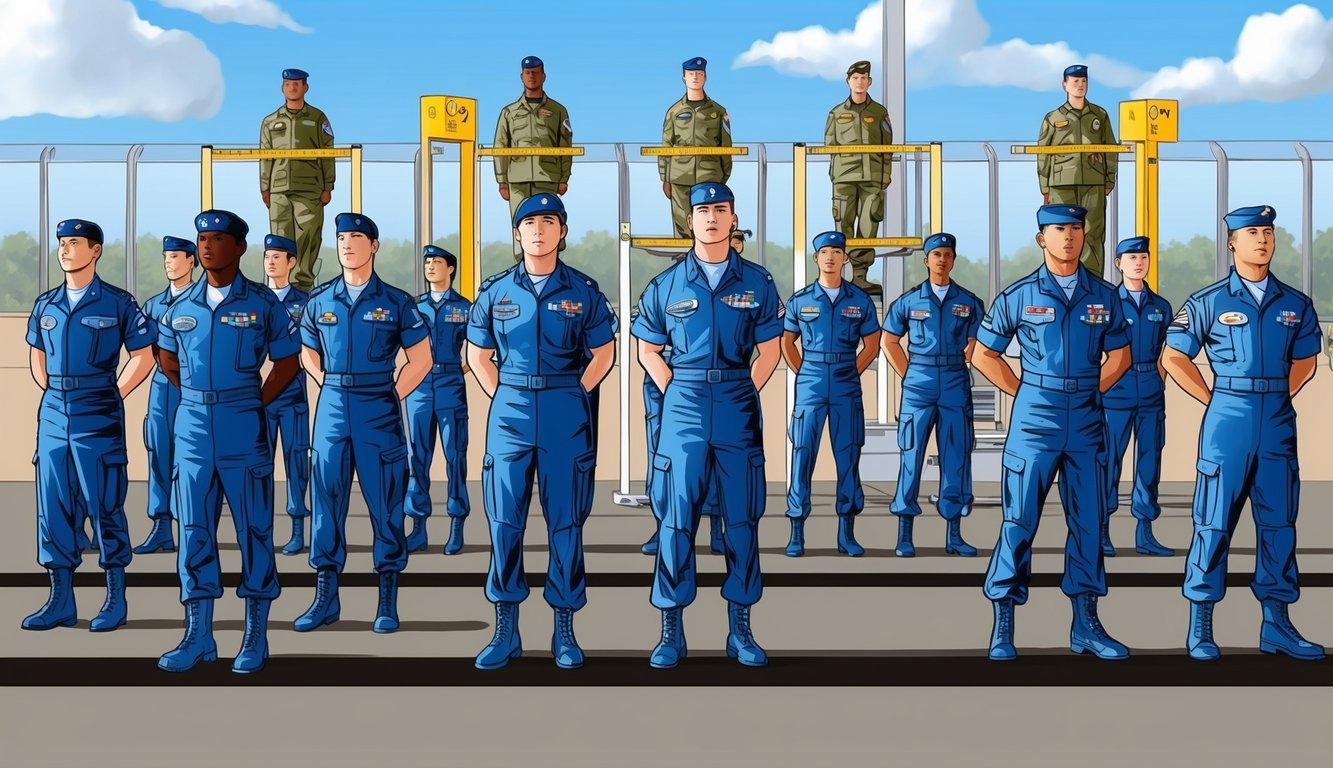
The Air Force upholds rigorous fitness standards to prepare Airmen for military service demands.
You’ll need to satisfy specific criteria in cardiorespiratory endurance and muscular strength to serve effectively.
Physical Fitness Test Components
The Air Force Physical Fitness Assessment (PFA) tests your overall fitness level, evaluated through three primary components:
- 1.5-mile run: Assesses aerobic capacity
- Push-ups: Measures upper body strength
- Sit-ups: Evaluates core strength
The test uses a point system, with each component contributing to your overall fitness score, which varies according to age and gender standards.
Meeting the Fitness Standards
To successfully pass the PFA, a minimum composite score of 75 out of 100 points is required.
Important tips include:
- Aim for the minimum score in each segment
- Target improvement in your weaker areas through regular training
- Consistent exercise is vital for maintaining fitness
The Air Force promotes a fitness-oriented culture.
Access to on-base gyms and fitness programs will help keep you in shape.
Remember, physical readiness is essential for mission success and your health as an Airman.
Medical and Health Considerations
The Air Force imposes strict medical and health standards to ensure personnel are fit for duty, encompassing vision, hearing, and overall wellness.
Vision and Hearing Requirements
Vision standards are stringent within the Air Force, requiring uncorrected visual acuity of at least 20/70 in each eye, correctable to 20/20.
While mild astigmatism is permissible, severe conditions may lead to disqualification.
Hearing capability is also critical.
You must pass audiometric tests that reveal hearing thresholds no greater than 25 decibels at specified frequencies.
If you use hearing aids, you might face certain restrictions.
Regular eye and ear examinations are required as part of your periodic health assessments, which help identify any developing issues at an early stage.
Health Risks and Medical Evaluation
Extensive screening takes place during medical evaluations to identify various health issues.
Conditions such as cardiovascular disease, diabetes, and hypertension are closely monitored.
Regular physical assessments and lab testing are conducted to reveal any problems that could affect your performance or long-term health.
Musculoskeletal injuries are a typical concern.
The Air Force provides advice on injury prevention and best practices for physical training.
If you have insulin-dependent diabetes or a history of stroke, disqualification may result; however, each situation is handled on a case-by-case basis.
Your routine health evaluations are critical for recognizing emerging health risks and ensuring you consistently meet medical standards.
Service Commitments and Training
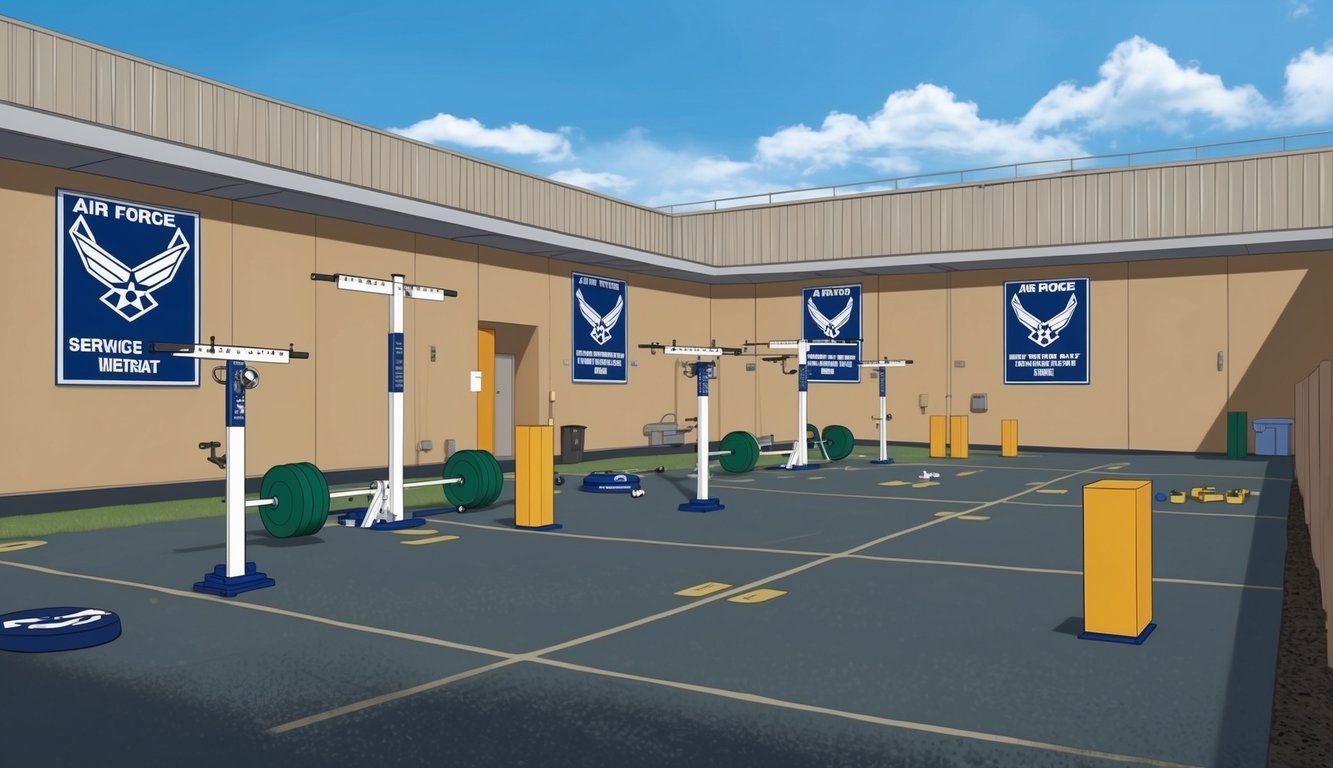
Enlisting in the Air Force entails substantial commitments and continuous training throughout your career.
You will begin with enlistment and basic training, followed by specialized education for your designated role.
Enlistment Process
To join the Air Force, meeting physical and academic standards is necessary.
Consult a recruiter to assess your options and take the ASVAB test.
If you qualify, you may select between immediate enlistment or the Delayed Entry Program.
The DEP enables you to enlist up to a year before proceeding to Basic Military Training (BMT), providing time for physical and mental preparation.
Once you ship out, you’ll undergo BMT for 8.5 weeks, covering military customs, fitness, and fundamental skills.
Ongoing Training and Education
After BMT, you’ll participate in technical training specific to your career field lasting from a few weeks to over a year, depending on your role.
As an airman, education remains a priority.
The Air Force offers:
- On-the-job training
- Professional military education courses
- Tuition assistance for higher education
- Opportunities for advanced degrees
Regular fitness assessments and skill certifications are part of your duties.
The Air Force heavily invests in your development to keep you mission-ready and promote career advancement.
Uniform and Appearance Regulations
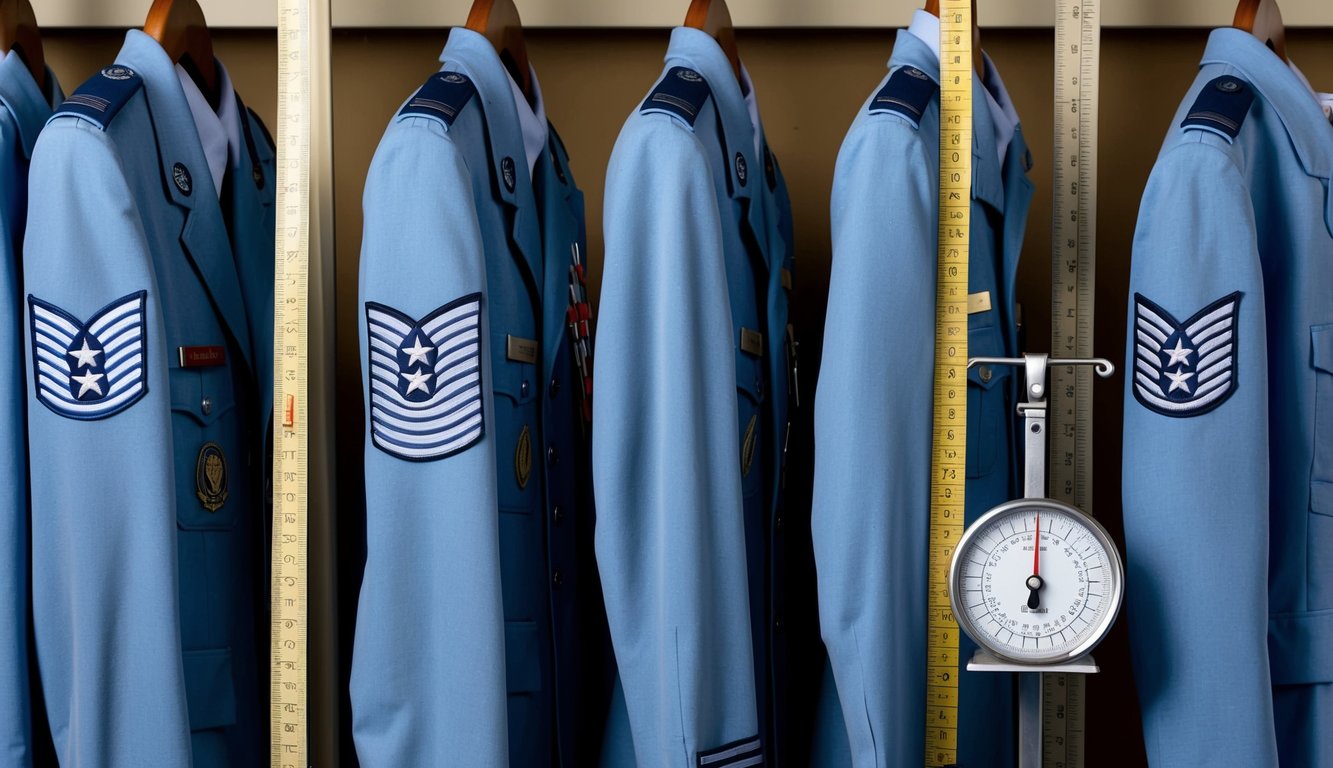
The Air Force has defined regulations regarding appearance and uniform standards.
These encompass guidelines on tattoos, piercings, and the proper wear of your uniform.
Tattoos and Piercings Policy
Being aware of tattoo and piercing regulations is essential when joining the Air Force.
Tattoos are permitted, though certain limitations exist.
You cannot have tattoos on your face, head, neck, or hands (except for one ring tattoo).
Tattoos on arms, legs, and torso are generally accepted if they are not excessive or offensive.
Piercing rules are more stringent.
Visible body piercings are not allowed while in uniform, including tongue, lip, nose, or eyebrow piercings.
Women may wear one small earring per earlobe, but men cannot wear earrings at all.
If you have tattoos or piercings that do not comply with these regulations, a waiver may be necessary.
It’s wise to consult a recruiter if you have uncertainties.
Dress and Personal Appearance
Your appearance in uniform is highly significant in the Air Force.
Hair must be neat and adhere to regulations.
For men, hair should be short and not extend to the ears or collar.
Women have more options, but hair must be secured and kept off the collar.
Your uniform should always be clean, pressed, and worn appropriately, encompassing everything from headwear to boots.
Pay attention to details like proper insignia placement, ensuring your shirt is tucked in.
Keep in mind, when in uniform, you represent the Air Force.
Aim to maintain a professional appearance at all times, avoiding behaviors such as chewing gum, using tobacco products, or walking while engaged with your phone.
Support and Resources
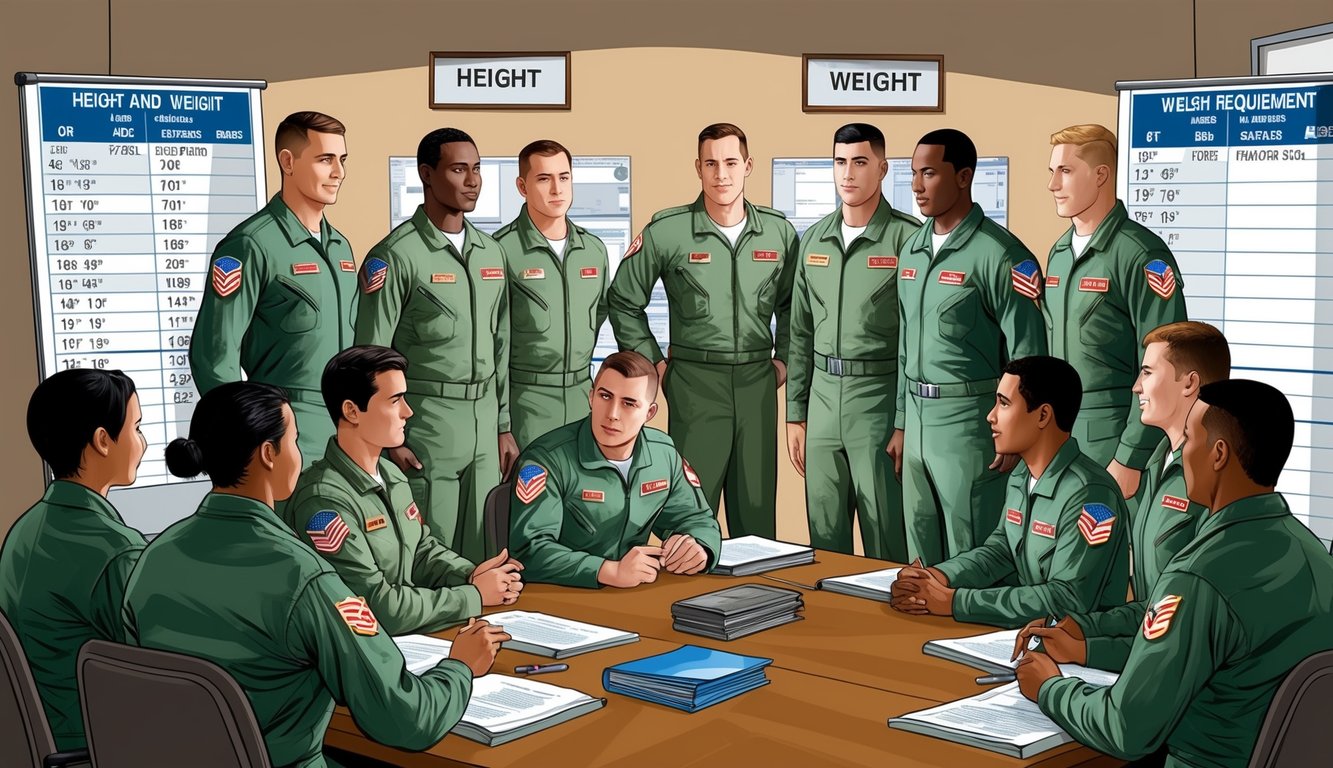
The Air Force offers various programs and resources to assist members in meeting height and weight standards.
These initiatives aim to support overall health and fitness while ensuring compliance with military regulations.
Body Composition Improvement Programs
If you find it challenging to meet body composition standards, specialized programs are available.
The Body Composition Improvement Program provides tailored support from human performance specialists, who work with you to devise a customized action plan addressing dietary, exercise, and lifestyle factors.
Medical treatment facilities can offer additional guidance and health screenings.
Additionally, the MyBodyComp tool can help you monitor your progress and set achievable goals.
Remember that these programs are designed to ensure your success rather than penalize shortcomings.
Holistic Health and Fitness Initiatives
The Air Force is transitioning from a reactive fitness approach towards a more comprehensive strategy.
Guardian Resilience Teams provide support focused on both physical and mental health.
These teams assist in developing sustainable habits that promote long-term wellness.
The MyFSS platform offers resources for nutrition, exercise, and stress management, including workout plans, healthy recipes, and tips for balancing military life with personal well-being.
By emphasizing holistic health, maintaining appropriate height and weight standards becomes more achievable naturally.
Department of the Air Force Integration
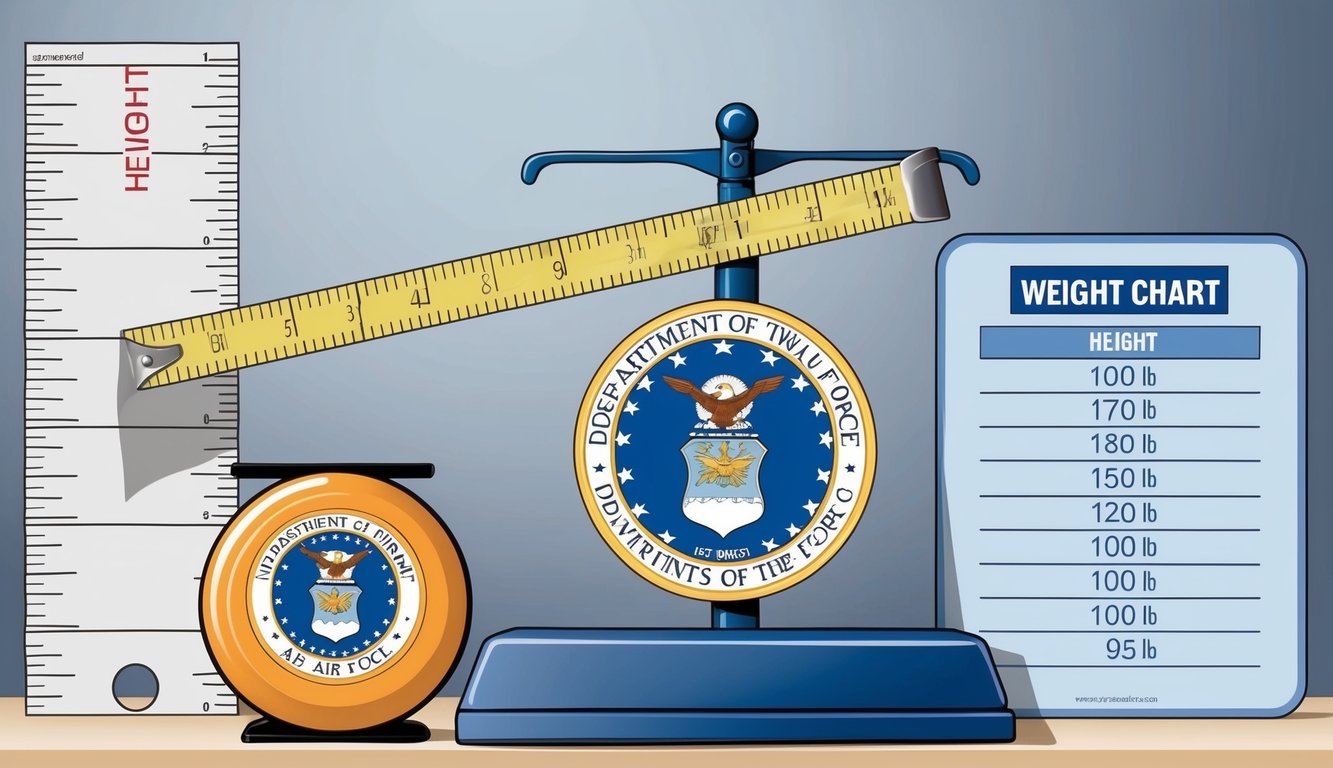
The Air Force and Space Force are implementing a new Body Composition Program (BCP) affecting both Airmen and Guardians.
It’s essential to be attentive to these updates if you serve in either branch of the military.
Beginning in April 2023, the Department of the Air Force introduced a Waist-to-Height Ratio (WHTR) into their updated BCP policy, replacing the former abdominal circumference assessment that was discontinued in 2020.
Lt. Gen. Caroline Miller, responsible for Inveantry, Personnel, and Services, reiterates the significance of this adjustment, emphasizing the need for individuals to sustain a healthy body composition as they undertake military responsibilities.
Here are some essential points to consider:
- This policy aligns with Department of Defense Instruction 1308.03.
- It applies to both Air and Space Forces.
- Assessments commenced in April 2023.
Katharine Kelley, Deputy Chief of Space Operations for Human Capital, highlights that integrating measures standardizes expectations across both services.
As a result, whether you’re an Airman or Guardian, physical fitness and body composition standards are now more consistent.
Adhering to these guidelines is crucial not just for compliance but for ensuring you are well-prepared for the distinct challenges associated with air and space operations.
Frequently Asked Questions
The Air Force enforces specific height and weight standards for applicants and service members, with requirements varying based on factors such as gender, age, and role within the organization.
What are the current height and weight standards for joining the Air Force in 2024?
The Air Force utilizes a Waist-to-Height Ratio (WHtR) to gauge body composition.
As of 2024, applicants must undergo a Body Composition Assessment (BCA) during their birth month.
Your waist circumference divided by your height must fall within acceptable parameters.
How do the Air Force’s weight requirements differ for men and women?
Weight standards in the Air Force are adjusted to reflect physiological differences between genders.
Female applicants generally have somewhat higher allowable body fat percentages compared to males at the same height.
What is the maximum allowable weight for an Air Force applicant based on their height?
The Air Force does not impose a rigid weight limit solely dependent on height; rather, they place emphasis on body composition and overall fitness.
Your WHtR is prioritized over absolute weight in determining eligibility.
Are there different physical requirements for different age groups in the Air Force?
Yes, the Air Force modifies fitness standards according to age categories.
As individuals age, the requirements for specific physical tests might relax slightly.
Nonetheless, all service members are expected to maintain a minimum fitness level.
How can someone calculate their acceptable height and weight range for the Air Force?
To estimate your acceptable height and weight range, measure your waist circumference and height in inches.
Divide your waist measurement by your height.
Generally, the Air Force looks for a ratio below 0.5, though exact standards might differ.
What happens during MEPS regarding height and weight assessments?
During your Military Entrance Processing Station (MEPS) visit, official height and weight measurements will be taken.
Medical personnel will document these metrics and assess your body composition to determine whether you meet the currently established standards for Air Force enlistment.
“`

